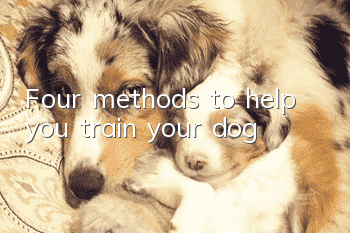Four methods to help you train your dog

A well-trained working dog mainly depends on nurture. Only with appropriate training methods can the dog's behavior be effectively trained and commanded. Training methods include induction, coercion, prohibition, rewards, etc.
Induction
Induction is a means by which the trainer uses influence methods that can induce the dog to engage in certain activities or certain actions that take advantage of the dog's spontaneity, and are used in conjunction with verbal commands and gestures to establish conditioned reflexes or enhance the training effect. For example, in the bite training, the trainer cheers the dog, and the assistant trainer provokes the dog, etc.
This method can make the dog's movements more exciting and natural, especially for sniffing and distinguishing odors. However, it should be used in conjunction with a certain degree of coercion, and the timing should be grasped. Use it more on quiet dogs and less on excited and flexible dogs.
Forced
Forcing refers to a method by which the trainer forces the dog to perform certain actions accurately and obey commands. Achieved through the use of strong mechanical reinforcements and threatening tonal passwords
In the early stages of training, the intensity of the coercion method should be moderate. The owner uses a normal tone to give the "come" command and at the same time pulls the mechanical pull of the traction rope; after entering the complex environment training, the owner uses a threatening tone to give the command to force the dog to make actions. . Use this combination multiple times or alone to enable the dog to establish conditioned reflexes.
However, coercion must be applied promptly and appropriately. Commands must be combined with mechanical pleasure of corresponding intensity. Coercion must be combined with rewards. For dogs that can tolerate strong stimulation, the intensity of pleasure can be increased appropriately. For dogs with strong sensitivities and timidity, the intensity of pleasure can be appropriately increased. For dogs, the intensity of stimulation is smaller. The training of basic subjects requires more use of force, and the training of subjects should be done with caution.
Forbidden
Prohibition refers to a means to stop a dog’s bad behavior. The use of threatening tones to deliver the "no" command, accompanied by powerful mechanical sounds, is essentially a form of punishment. When a dog eats food from others, the owner should promptly use the "no" command or a mechanical device that pulls the traction rope at the same time to stop it. After repeated use in this way to establish conditioned reflexes, the purpose of prohibition can be achieved by simply using the "no" command. However, the dog's bad behavior must be stopped in time. It should be used at the initial expression and should not be used after the bad behavior occurs.
Rewards
Refers to a strengthening method to accelerate the development and consolidation of the dog's working ability, as well as to make the dog obey the command, make correct movements, and maintain the dog's excitement for working. Including food, petting, picking up objects, wandering and "good" commands, etc. If the dog completes a certain correct action, you can pat the dog's shoulder to show encouragement.
However, rewards and punishments must be timely, seize the opportunity, and the attitude must be gentle when rewarding. The methods of rewards vary depending on the training subjects, and rewards should be used correctly according to the training requirements at different stages.
- How long does it take for Teddy's hair to become curly?
- How much does it cost to vaccinate a puppy? Puppy vaccination precautions
- A super comprehensive summary of dog deworming knowledge, you will understand it all after reading this article!
- Warm spring is coming, how to effectively remove pet hair loss?
- These hidden bone diseases in dogs cannot be ignored
- What are the causes of dogs’ runny noses?
- Why do Welsh Terriers have body odor?
- Is it useful to take oxytetracycline for dogs with diarrhea?
- How long does it take for a puppy to grow?
- What should I do if Teddy doesn’t like drinking water?



